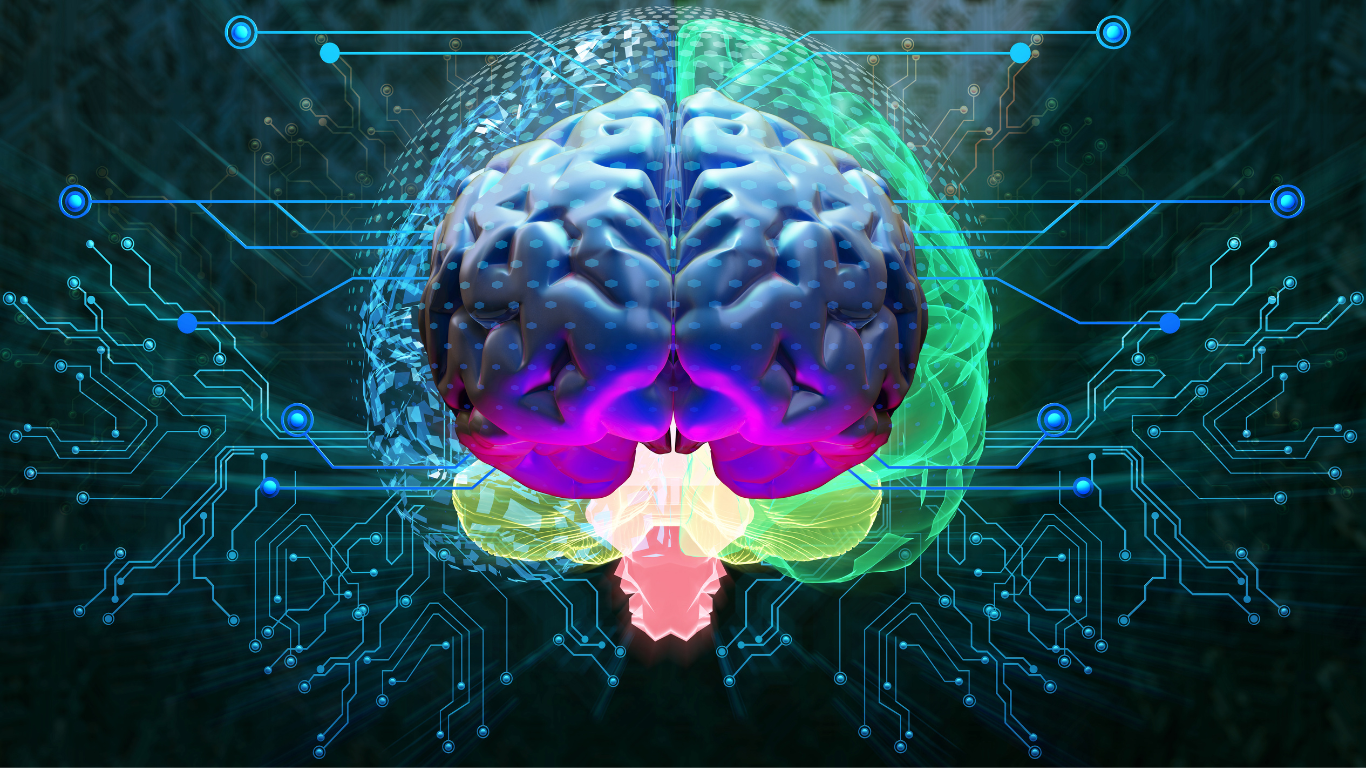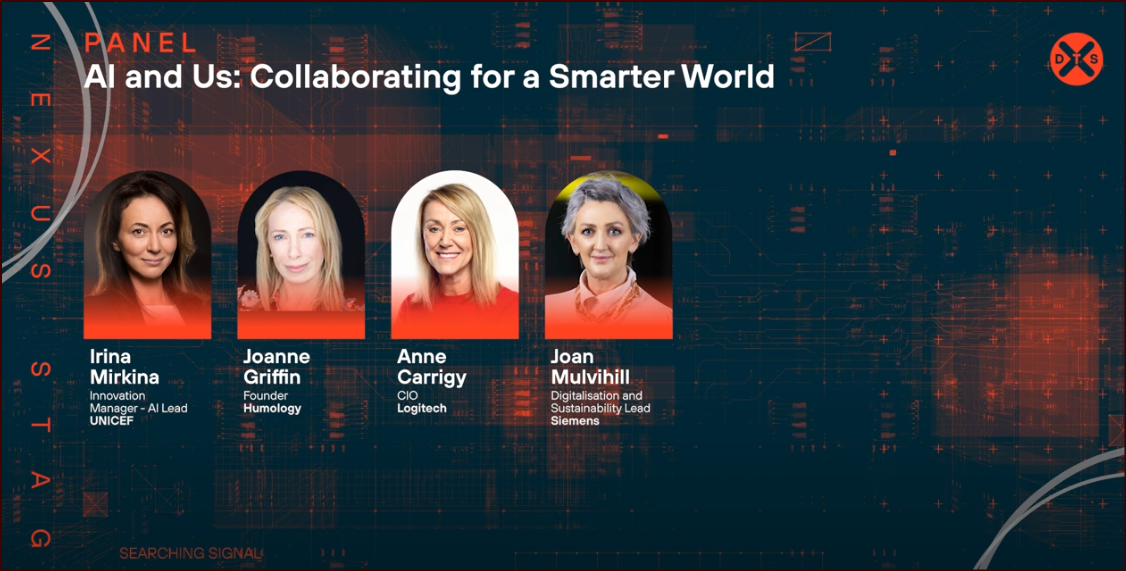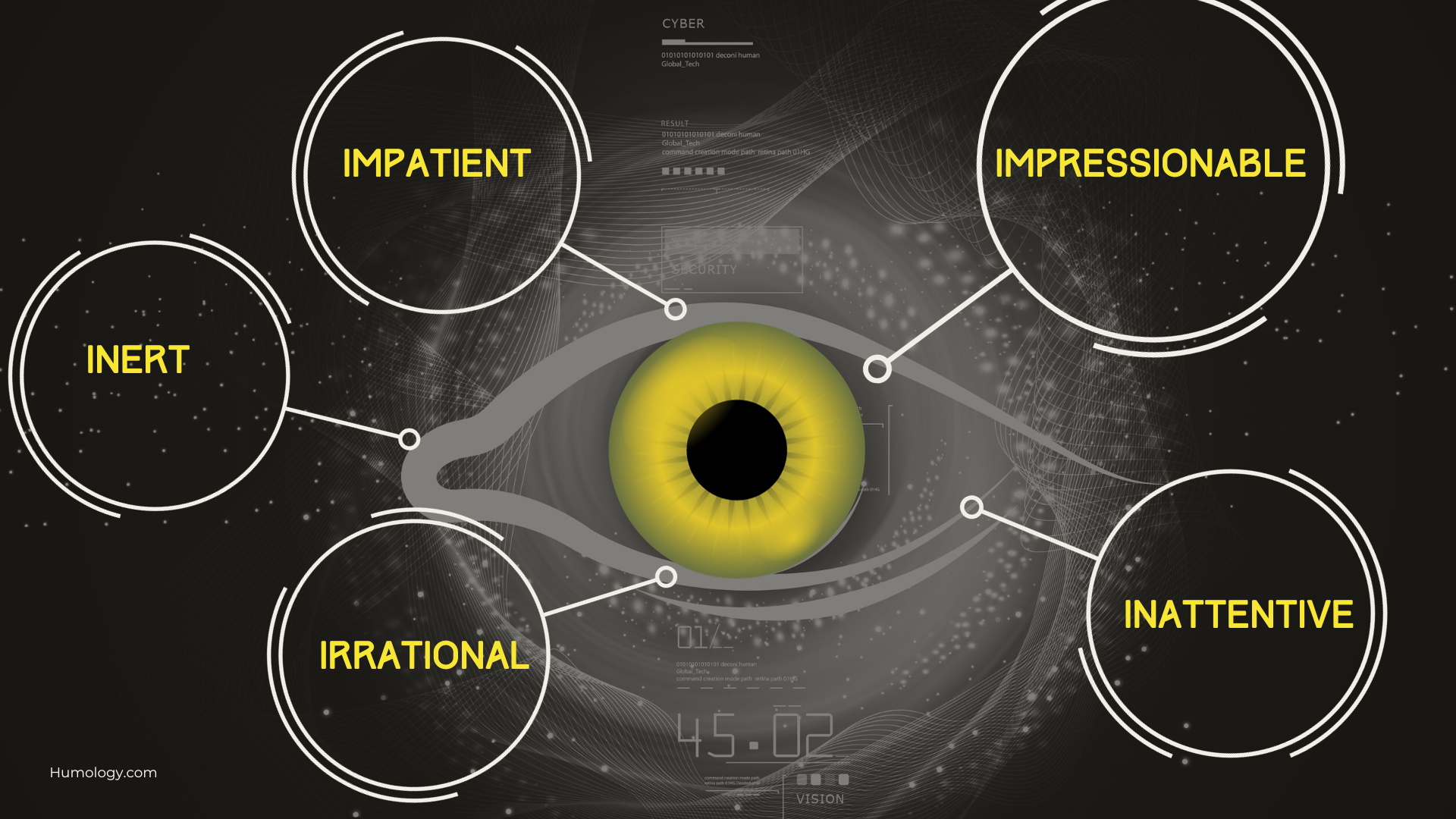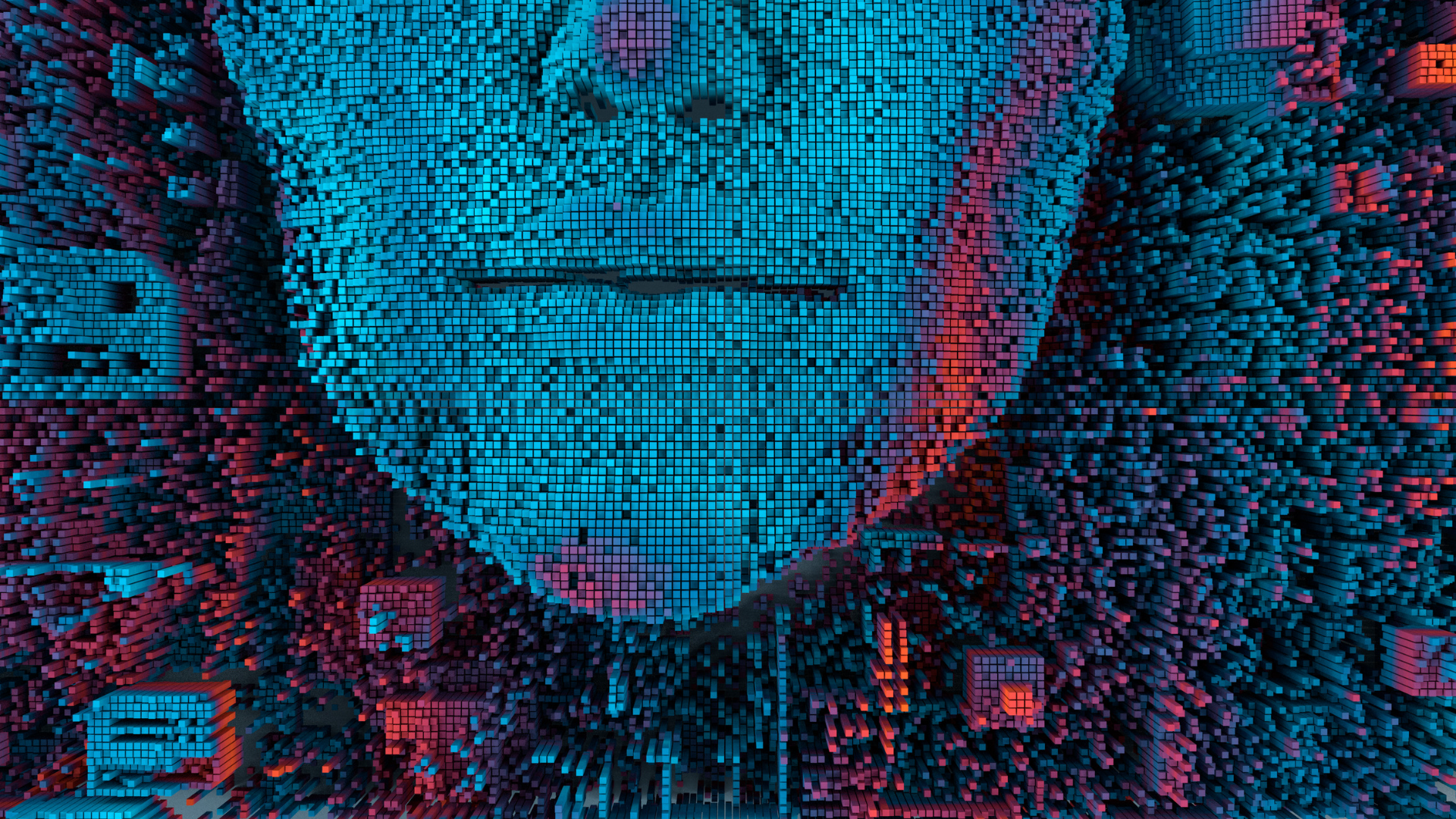Is ChatGPT a Game Changer for Change Management?
You have probably heard of ChatGPT, and you may even be one of the million users who signed up for and started to use this viral sensation in the first five days after it was released. It is an Artificial Intelligence system based on NLP (Natural Language Processing) owned by Open AI, a San Francisco-based AI and research company. It has created much buzz lately and indicates the seismic shift AI will bring to most industries and professions. Think of it as a chatbot on steroids. It is still free to use; you only need an email address to sign up and start using it.
This technology can provide intelligent conversations, answers to questions, and even generates content when given a prompt. People have been using ChatGPT to create college essays, advertising copy, website content, poetry, jokes, computer code, and more.
The performance of ChatGPT is awe-inspiring. For example, it was recently able to receive a solid grade for an MBA exam at Wharton Business School. I believe this is a true watershed moment for AI in two ways. First, it is raising awareness of the potential of AI among the public and second, it is putting AI in the hands of the masses.
In this article, I will explain what ChatGPT is, and the underlying technology in what I hope are easy-to-understand terms. I will also look at the implications for the organisational change management profession, including how we might utilise this new tool. There are, of course, some potential downsides to this technology, including ethical and copyright concerns, which I will also discuss.
What is ChatGPT?
ChatGPT is the latest version of the GPT AI tool. GPT stands for Generative Pre-trained Transformer. Generative AI is a form of AI used to generate new content. Applications include text-to-image, text-to-computer code, text-to videos and text-to-audio. Developed using machine learning, GPT has been pre-trained on enormous datasets based on internet content, including all of Wikipedia, essentially a significant portion of the internet. A transformer is a type of artificial neural network (ANN) architecture developed in 2017 by Google, which allows for greater parallelisation of processing, essentially meaning that if you have the proper hardware, you can train a model on a vast dataset. An ANN is a machine learning form inspired by how neurons operate in our brains.
Before the release of ChatGPT in November, the core tool, GPT3, was only available to programmers and developers who could access the tool via an API (Application Programming Interface). Many exciting and innovative start-ups were created using this API, including Copy.AI, Writesonic and Jasper.
Use Cases for Change Management
For me, the best use of ChatGPT is helping you overcome the blank page moment when creating content. So, whether you're drafting a status update on your project, drafting an email to your stakeholders or change sponsor, you can use ChatGPT to provide some suggestions to you that you can flesh out. Here are some more use cases for ChatGPT in change management:
- Use ChatGPT as a memory jogger on change management concepts and models as an alternative to going back to your notes or textbooks. For example, ask ChatGPT to remind you what the five components of the ADKAR model are and how they might be applied. Or ask what the eight steps in Kotter's model are and provide practical steps to implement for each.
- You can use ChatGPT to role-play a conversation ahead of a challenging meeting. You can ask ChatGPT to act as a stakeholder who is resistant to the change and have a simulated conversation with them to help prepare.
- I have seen examples of people using ChatGPT to create outlines and content for training courses.
- One of the best features of Chat GPT is the ability to summarise text. You could submit a one-page description of your project and ask it to summarise it in one paragraph.
- Compare your project communications to your organisation's corporate communication for style and tone. (Note this is more of a stretch than the previous points and would require you to fine-tune the model).

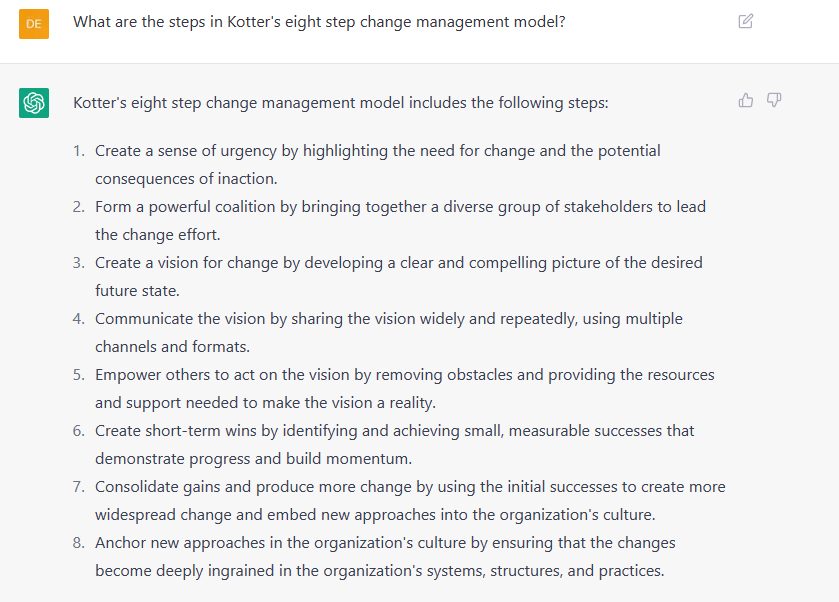
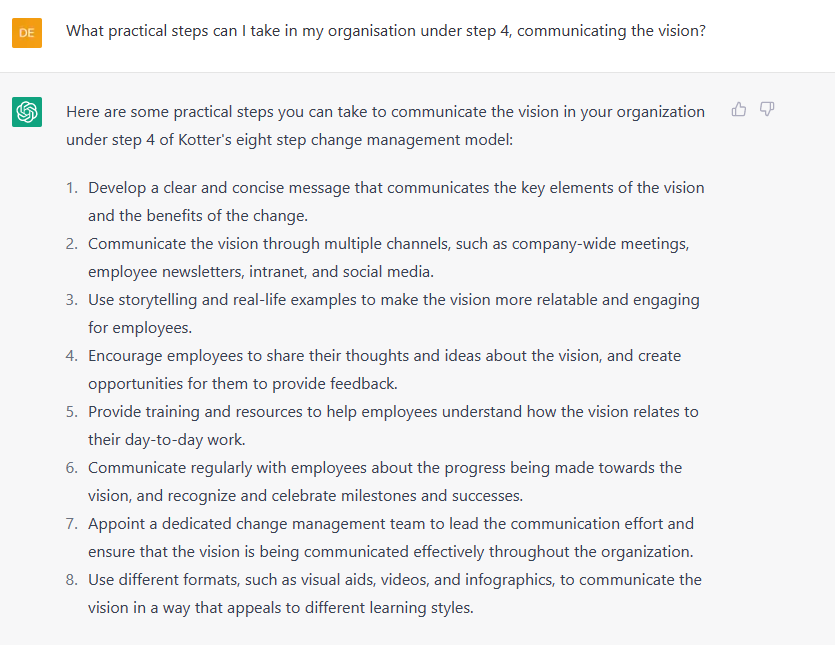
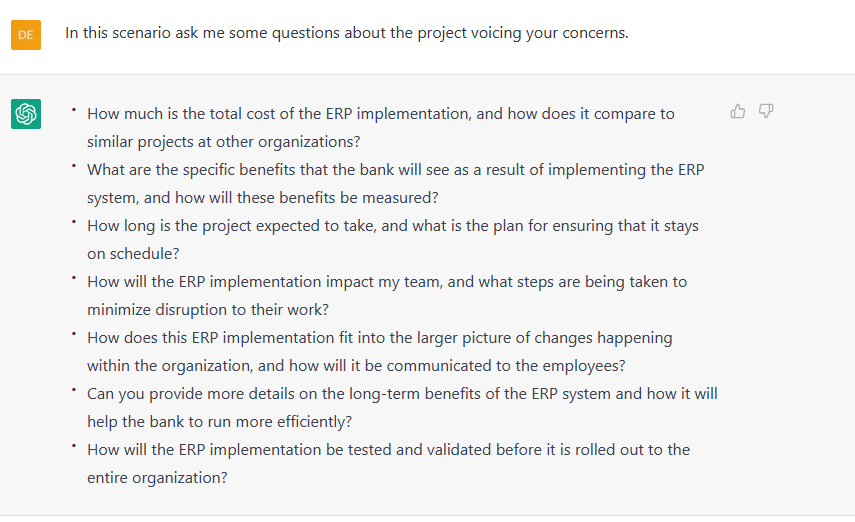
Does this mean that I am advocating that Change Managers are obsolete and should be automated? Not at all. This is an excellent example of where humans and machines working together can achieve so much more than machines or humans working separately. Thought leaders in this area, including Professor Thomas Malone of MIT, have advocated for a collective intelligence approach, where 'people and computers can be connected so that collectively they act more intelligently than any one person, group, or computer has acted before" (The Economist).
Downsides
Of course, as with any new technology, we need to be mindful of the potential negative side of ChatGPT and the possible unintended consequences.
ChatGPT, likely many LLMs (Large Language Models), is prone to 'hallucinations' or confabulations. That is, it can produce content that is confident and plausible yet does not align with the data it was trained on. There are instances where it includes non-existing references or sources. Remember when using ChatGPT that the model is just trying to predict the next word and does not fact-check itself!
Some critics of LLMs claim that they are nothing more than 'stochastic parrots' that repeat back phrases that they have seen in their training datasets with a deliberate element of randomness introduced to ensure all output is not identical and seems authentically random.
Copyright is also an issue that is still to be resolved with these generative AI tools. A group of artists are suing Stable Diffusion and Midjourney. When a user requests one of these models to create an image 'in the style of' a particular artist, these tools use data allegedly scraped from the web without the artist's consent (Vincent). Similar accusations have been made against the owners of the generative AI tool CoPilot, which has been trained on lines of programming code scraped from the web. Some critics also warn of a Cyrano de Bergerac dystopia where everyone uses AI to articulate things beyond their capacity to express.
From an ethical perspective, we also need to spare a thought for the low-paid workers tasked with removing offensive and obscene material in the datasets used to train ChatGPT. Time magazine has reported that this task was outsourced to workers in Kenya earning less than $2 per hour, requiring them to read hate speech and descriptions of violence and sexual abuse. We should also be mindful of the environmental impacts of developing these LLMs (Perrigo). A recent study indicated that training an LLM creates 284 tons of CO2; compared that to the five tons, humans are estimated to be responsible for per year(Garcia and Gasser). Open AI will also need to address how to prevent the tool from being used to generate scam emails and computer malware code.
Finally, under downsides, we need to be mindful of the bias that can be a problem for any machine learning model. As mentioned above, Wikipedia is a vital component of the source training data, yet less than 15% of Wikipedia users are women (Garcia and Gasser).
Other Recent Developments
Open AI has been quite transparent that the current version of ChatGPT is a free research preview of the tool. There is speculation that they will introduce a premium model expected to cost around $42 per month and provide greater reliability. The current version is prone to being unavailable for periods due to heavy demand.
Now several tools are available that you can use to detect text that ChatGPT and other AI tools have generated. This is AI being used to detect AI content!
Microsoft has announced that it will make a further billion-dollar investment in Open AI, following the $1 billion it invested in 2019. This seems like a wise move from Microsoft as it can integrate GPT3 with Bing to make it a viable alternative to Google search. In addition, the investment helps Microsoft to develop and market its Azure cloud computing platform.
Future Developments
It will be interesting to see how Microsoft will integrate ChatGPT with the Bing search engine and what Google's response will be. You may recall that the Google-owned LLM, LaMDA, was in the news last year when a Google engineer claimed the model had become sentient.
We are likely to see vendors and even some larger organisations fine-tuning GPT models with relevant training data to enable the model to produce better, more value-adding output for change management use cases. Access to proprietary data and the ability to fine-tune models will determine the successful application of GPT models.
GPT-4, the next version of GPT, is likely to be released sometime this year. There is speculation that it will be significantly more powerful than ChatGPT, but Open AI has tried to dampen down some over-enthusiastic expectations for that release. Much of the speculation about GPT4's performance centres on the expected number of parameters the model will have. This is reported as 100 trillion parameters as opposed to the 175 billion parameters in GPT-3. You will see the expression parameters used a lot in discussions about ChatGPT and other LLMs so it is worth knowing what they are. When we train a LLM on a text dataset, the system learns the relationships between patterns and words; these are the parameters. You can also think of a parameter as a Lego building block. The more Lego blocks you have, the bigger and more complex the Lego model you can build. It works the same for LLMs.
Conclusions
We are at an exciting time for AI. It has gone from science fiction to buzzword to now being a true enabler of business transformation. Similar to other roles impacted by AI, my advice to those in the change management professions is that you will not be replaced with AI, but you may be replaced by someone who can leverage AI to add more value to an organisation or project.
In addition, I believe the Organisational Change Management (OCM) profession is well-placed to assist organisations in preparing for AI. Change Managers will need to help with the broader culture change piece, including education and understanding about AI in general, including addressing the concerns about bias and fairness in ML algorithms.
The right question to focus on is not which jobs AI will replace but rather, we should look for opportunities where humans and machines can perform better together than machines or humans could ever do separately.
The introduction of AI tools can free change managers up to perform more value-adding activities, e.g. attending meetings with impacted stakeholders, walking the floor and having more time to engage with sponsors and stakeholders. I, for one, am optimistic and excited about what AI has to offer.
References
The Economist. "Why Collaborative Thinking Beats Individual Smarts." The Economist, 18 June 2018, www.economist.com/open-future/2018/06/18/why-collaborative-thinking-beats-individual-smarts.
Garcia, Esther Sanchez, and Michael Gasser. " Stochastic Parrots: How NLP Research Has Gotten Too Big". SftP Magazine." Science for the People Magazine, 2 Oct. 2021, magazine.scienceforthepeople.org/vol24-2-dont-be-evil/stochastic-parrots/. Accessed 14 Dec. 2021.
Jack, Andrew. "AI Chatbot's MBA Exam Pass Poses Test for Business Schools." Financial Times, 21 Jan. 2023, www.ft.com/content/7229ba86-142a-49f6-9821-f55c07536b7c. Accessed 25 Jan. 2023.
Perrigo, Billy. "Exclusive: The $2 per Hour Workers Who Made ChatGPT Safer." Time, 18 Jan. 2023, time.com/6247678/openai-chatgpt-kenya-workers/.
Vincent, James. "AI Art Tools Stable Diffusion and Midjourney Targeted with Copyright Lawsuit." The Verge, 16 Jan. 2023, www.theverge.com/2023/1/16/23557098/generative-ai-art-copyright-legal-lawsuit-stable-diffusion-midjourney-deviantart. Accessed 16 Jan. 2023.

